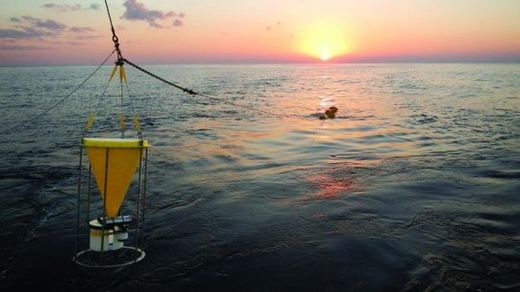
The research aids in understanding what happens to Fukushima contaminants after they are buried on the seafloor off coastal Japan.
Led by Ken Buesseler, a senior scientist and marine chemist at the Woods Hole Oceanographic Institution (WHOI), the team found that a small fraction of contaminated seafloor sediments off Fukushima are moved offshore by typhoons that resuspend radioactive particles in the water, which then travel laterally with southeasterly currents into the Pacific Ocean.
"Cesium is one of the dominant radionuclides that was released in unprecedented amounts with contaminated water from Japan's Fukushima Daiichi nuclear power plant following the March 11, 2011, earthquake and tsunami," says Buesseler. "A little over 99 percent of it moved with the water offshore, but a very small fraction--less than one percent--ended up on the sea floor as buried sediment."
"We've been looking at the fate of that buried sediment on the continental shelf and tracking how much of that contaminated sediment gets offshore through re-suspension from the ocean bottom," he adds.
The research team, which included colleagues from the Japan Agency for Marine-Earth Science and Technology and the Japan Atomic Energy Agency, analyzed three years' worth of data collected from time-series sediment traps.
Researchers deployed the pre-programmed, funnel-shaped instruments 115 kilometers (approximately 70 miles) southeast of the nuclear power plant at depths of 500 meters (1,640 feet) and 1,000 meters (3,280 feet). The two traps began collecting samples on July 19, 2011--130 days after the March 11th earthquake and tsunami--and were recovered and reset annually.
After analyzing the data, researchers found radiocesium from the Fukushima Daiichi Nuclear Power Plant accident in the sediment samples along with a high fraction of clay material, which is characteristic of shelf and slope sediments suggesting a near shore source.
"This was a bit of a surprise because when we think of sediment in the ocean, we think of it as sinking vertically, originating from someplace above. But what this study clearly shows is that the only place that the material in our sediment traps could have come from was the continental shelf and slope buried nearshore. We know this because the coastal sediments from the shelf have a unique Fukushima radioactive and mineral signal," says Buesseler.
The data also revealed that peak movements of the sediments with radiocesium coincided with passing typhoons which likely triggered the resuspension of coastal sediments. Radiocesium was still detected in sediment samples from July 2014.
"The total transport is small, though it is readily detectable. One percent or less of the contaminated sediment that's moving offshore every year means things aren't going to change very fast," Buesseler says. "What's buried is going to stay buried for decades to come. And that's what may be contributing to elevated levels of cesium in fish--particularly bottom-dwelling fish off Japan."
Comment: That's assuming that nothing else disrupts the seafloor where these contaminates are buried; however scientists have warned that Japan may have entered an era of great earthquakes and volcanic eruptions. Many of Japan's volcanoes are showing high levels of activity and there have been large-scale volcanic eruptions before or after major earthquakes around the world.
While there were hundreds of different radionuclides released from the Fukushima Daiichi Nuclear Power Plant during the disaster, after the initial decay of contaminants with half lives (the time it takes for one half of a given amount of radionuclide to decay) less than days to weeks, much of the attention has remained focused on cesium-137 and-134-- two of the more abundant contaminants. Cesium-134 has a half-life of a little over two years, and so any found in the ocean could come only from the reactors at Fukushima. Cesium-137 has a half-life of roughly 30 years and is also known to have entered the Pacific as a result of aboveground nuclear weapons tests in the 1950s and '60s, providing a benchmark against which to measure any additional releases from the reactors.
In October, Buesseler and the research team will return to Japan to redeploy more sediment traps. The continued study will help estimate how long it takes to decrease the level of radiocesium in seafloor sediments near the Fukushima Daiichi Nuclear Power Plant.
Story Source: The above post is reprinted from materials provided by Woods Hole Oceanographic Institution. Note: Materials may be edited for content and length.
Journal Reference:
- Ken Buesseler, Michio Aoyama, Masao Fukasawa. Impacts of the Fukushima Nuclear Power Plants on Marine Radioactivity. Environmental Science & Technology, 2011; 45 (23): 9931 DOI: 10.1021/es202816c



Comment: The authors seem to downplay the risks associate with these buried contaminates while ignoring the ongoing serious environmental and health consequences from this disaster.